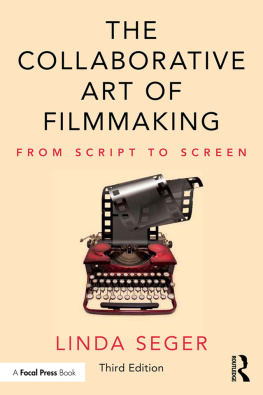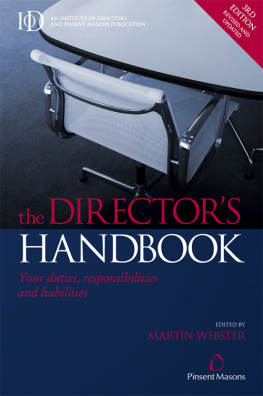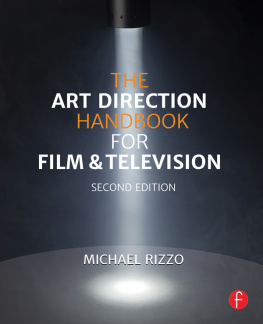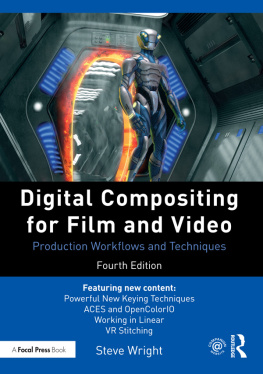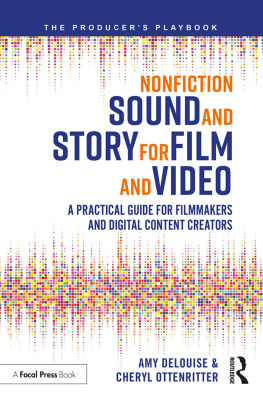Art Direction for Film and Video
Art Direction for Film and Video
SECOND EDITION
Robert L. Olson

First published 1999
by Focal Press
70 Blanchard Road, Suite 402, Burlington, MA 01803
Simultaneously published in the UK
by Focal Press
2 Park Square, Milton Park, Abingdon, Oxfordshire OX14 4RN
Focal Press is an imprint of the Taylor & Francis Group, an informa business
1999 Taylor and Francis
No part of this publication may be reproduced, stored in a retrieval system, or transmitted in any form or by any means, electronic, mechanical, photocopying, recording, or otherwise, without the prior written permission of the publisher.
Library of Congress Cataloging-in-Publication Data
Olson, Robert L., 1925
Art direction for film and video / Robert L. Olson. 2nd ed.
p. cm.
Includes index.
ISBN-13: 978-0-240-80338-8 ISBN-10: 0-240-80338-8 (alk. paper)
1. Motion picturesArt direction. 2. Motion picturesSetting and scenery. 3. TelevisionStage-setting and scenery. I. Title.
PN1995.9.A74048 1998
791.43025dc21
98-25752
CIP
British Library Cataloguing-in-Publication Data
A catalogue record for this book is available from the British Library.
To Gabor Kalman,
a friend indeed
CONTENTS
This book details the thinking and basic drawing techniques art directors and production designers need and follows the progress of typical projects from script analysis to setup on stage and location. Even though other helpful books are available that communicate techniques, this book, based on the work experience of a film and video art director, relates technique to everyday work experiences every art director encounters.
WHO CAN BENEFIT FROM THIS BOOK?
Film students can make their projects more professional looking by knowing how to realistically ask for help with location and set projects. Producers, directors, and writers can see how an efficient art director can work with them more effectively. Designers such as graphic artists, advertising art directors, layout artists, and painters and sculptors, can learn how to adapt their skills to film and video projects. Anyone considering a career in video and film art direction can see what the profession is really like.
The second edition includes a lot of new material that will enhance the readers perception of realistic work experiences and technological advances now available to production designers and art directors.
A new chapter Production Designers Use Special Effects illustrates how designers utilize digital editing, improved miniatures, and stage and laboratory techniques. Statements from special effects experts and production designers describe concepts and processes they use to accomplish the compelling film effects audiences marvel at today.
Also, chapters detailing the process of designscript analysis, sketching, construction drawingset decoration, and stage and location work, feature quotes from working designers and craftspeople who share their experiences in solving production problems.
In this book, readers can learn enough basic skills to function as beginning art directors, which are the preamble to using advanced techniques in future careers in the film and video industries.
ABOUT THE AUTHOR
The author has worked as an art director and set designer at the major motion picture and television facilities in Los Angeles, as well as freelancing for many corporate, entertainment, and cable television producers. Along with professional work, the author created and taught a continuing art direction curriculum for the UCLA Extension program, including several one-day design seminars featuring top Hollywood production designers. Other seminars include a week-long course for the Televisa Mexico design staff in Mexico City, a Stanford University Summer Workshop, and courses at The Art Center College of Design, in Pasadena, California.
The author wishes to thank the editors and staff at Focal Press for their valuable assistance in preparing this second edition, and the many talented, creative people in the film and television industry who have contributed their expertise.
This book is for anyone who wants to learn about production design and art direction, whether they are students, producers, directors, writers, or designers from other fields who want to work in film and video. Easy-to-understand practical terms encourage the reader to apply imagination to everyday design problems.
Due to the wide-ranging nature of this book, I have divided the information into three parts: The Role and Responsibilities of the Production Designer, Outline of a Job, and Typical Sets and Opportunities.
illustrates where production designers came from, what a production designer is and does, and basic materials and tools used by designers. Various examples show different projects and solutions.
tracks a dramatic series pilot from script to wrap-up. By following the detailed illustrated instructions, a beginner can learn to analyze the script; research the characters environments; work effectively with the producer and director; produce sketches and construction drawings; make a model; and supervise the construction, setup, and decoration of the set.
details several typical design challenges met in professional work situations: a series pilot shot on location, a talk show, a new broadcasting environment, and a film commercial. The last chapter tells the beginner how to prepare a portfolio and rsum and how to look for work in the film and broadcasting industries.
To understand the origin and development of production design, we will first see how the increased popularity and improved technology of motion pictures required better stories and acting, as well as more believable settings. Many designers came from the theater, along with theatrical setting techniques, but as the film industry developed, designers created design and building techniques that satisfied the needs of a new medium.
describes the production designers responsibilities, basic set elements, the production environment in which the designer works, and illustrates lighting techniques that affect the designers work.
Production designers develop a visual plan for an entire production, including sets, props, costumes, color schemes, lighting, and frequently the entire flow of a film. Because film is a visual medium, the look the production designer establishes can involve the audiences emotionally as much as story lines and dialogue.
Up until the late 1930s, the title art director generally meant the same as production designer does today, but when David Selznick gave special recognition to William Cameron Menzies for his comprehensive work on Gone with the Wind, this special title later came into general use. Because art directors became production designers, art directors now carry out the production designers overall plans for films.
According to Bruce Block, visual consultant for the Meyers/Shyer Company, Burbank, CA:
Real production design means that you have designed the production. If its on stage, you design the sets, costumes, and the lighting, and youre through. If its a movie, you have to figure out what the camera is doing. The visual components are space, line, color, movement, and rhythm. Thats what production design is all about.
The production designer has to understand what the movie is about. Its not the plot; its what I like to call point of viewwhat you want the audience to feel about the movie.
In Father of the Bride, we wanted the house to be a character in the movie. The house was not a backdrop; it was a part of the family like Steve Martin was, so we had to find a production designer who was smart and understood what point of view means and who could bring something to the table besides wallpaper and paint samples.
Next page

